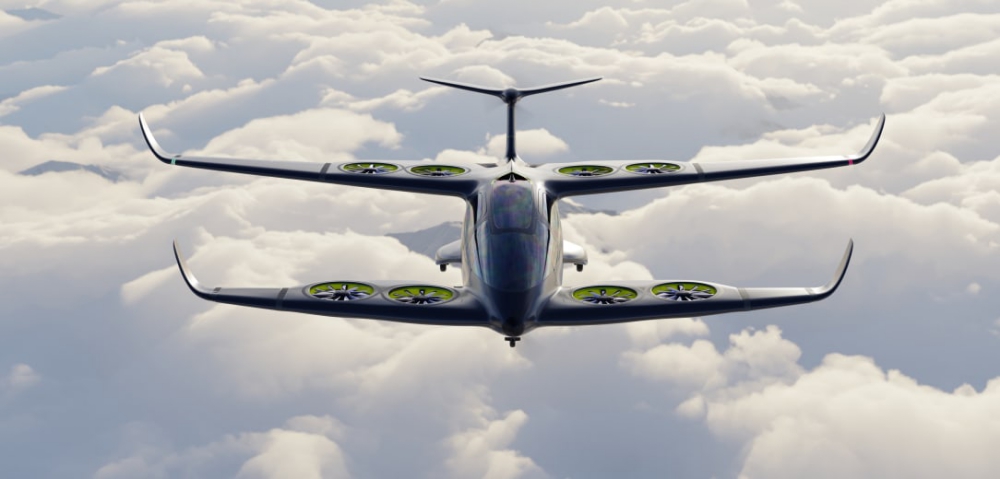After three years of R&D, the French start-up Ascendance Flight Technologies builds on the virtues of hybrid technology and distributed propulsion to develop sustainable air travel solutions unveiling the design of ATEA, its 5-seater vertical take-off and landing aircraft.
Conceived to operate in peri-urban areas and within regions thanks to a range of 400 km, carbon emissions reduced by 80% and noise pollution divided by 4, ATEA blends sleek and audacious design with unprecedented “fan-in-wing” technology and optimised engine configuration. Production is scheduled for 2025.
Equipped with tailor-made modular hybrid engines developed by Ascendance Flight Technologies, ATEA is tomorrow’s aircraft: designed to satisfy the high demands of both passengers and stakeholders of reinvented aviation. Its architecture and design foresee the future of airborne mobility, responding to societal and environmental expectations and to the most recent certi cation rulings. The technological innovations integrated in ATEA ensure an optimised, easy-to-use and agile operation required for a variety of uses, whether for passenger transport, emergency services, logistical tasks or for surveillance ights. Modular hybrid-electric propulsion “Lift + Cruise” configuration with 2 separate propulsion systems for vertical and horizontal ight 8 rotors integrated into two xed wings 2 horizontal propellers Skyview cabin and easy access for passengers
“We set-up Ascendance Flight Technologies with a very clear vision of what we wanted to achieve: to accelerate transition towards green aviation thanks to hybrid technology” says Jean-Christophe Lambert, co-founder and CEO. “The design of ATEA is the concrete re ection of our values, our experience and of our know-how. The aircraft we are presenting to you today is the result of huge efforts by our R&D department, tests and trials on 4 prototypes and a great deal of thought on costs and the ease of ying such an aircraft. Its characteristics provide all the performances expected by a sector that the ongoing transition has made more demanding”.
DESIGN WHICH UNITES ENERGY EFFICIENCY, DISCRETION AND SAFETY
The new ATEA con guration has integrated a hybrid system patented by Ascendance called STERNA. This system is devised on an electric engine powered by the merging of two energy sources: combustion and electric (battery). Over time, the company is planning to phase out the combustion energy source and replace it with new sources of cleaner energy such as hydrogen or Sustainable Aviation Fuel.
Eight new generation rotors are now featured on a tandem wing configuration according to the “fan-in- wing” principle. Patented by Ascendance, this shrouded rotor technology allows increased power during the take-off and landing phases in addition to signi cant noise reduction. The number of rotors guarantee manoeuvrability of the aircraft in case of failure, with resilience being compliant with regulatory requirements.
The Lift and Cruise system of the aircraft provides separation of vertical and horizontal ight which are ensured by the rotors for the former and by propellers located in the nose and tail n for the latter. The resulting absence of pivoting mechanisms therefore reduces risk of failure, which also simpli es the aircraft’s certi cation while improving overall aircraft safety.
“ATEA will soon exist in the form of a full scale prototype and will go into testing phase in 2023” Jean-Christophe Lambert informs us. “With help from our financial partners we are now experiencing vigorous development. We are actively recruiting, running test and trial programs and we are steadily moving towards our 2025 certi cation objective.”
ABOUT ASCENDANCE FLIGHT TECHNOLOGIES
Founded in 2018 by Jean-Christophe Lambert, Thibault Baldivia, Clément Dinel and Benoît Ferran, Ascendance Flight Technologies is a start-up that has set itself the mission of decarbonizing aviation. Established in 2020 in the heart of Toulouse, the European aeronautics capital, it is developing an innovative hybrid propulsion system called STERNA and a vertical take-off and landing aircraft (VTOL) tted with this technology, called ATEA.
ATEA is the future of vertical mobility. This 4-to 5-seat aircraft is a vertical take-off and landing aircraft designed as a clean, quiet and e cient alternative to the helicopter and will be presented in partnership with ADP at the 2024 Olympics. With its 400-km endurance and reduced noise emissions, it is designed for urban and regional use in passenger transportation, tourism, medical emergencies, logistics and surveillance.
STERNA is a hybrid propulsion technology which unlocks cleaner air mobility. STERNA’s innovative electric architecture and embedded intelligence allow for simultaneous use of several energy sources. STERNA is modular, so it can accommodate a thermal module or new hydrogen solutions, helping drive energy transformation in the aviation industry. The company has led several patents on these technologies.
Source: Press Release

